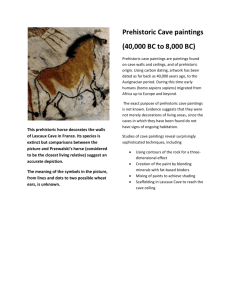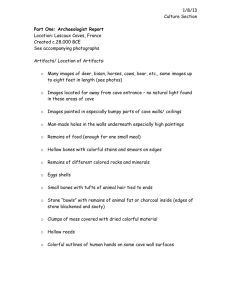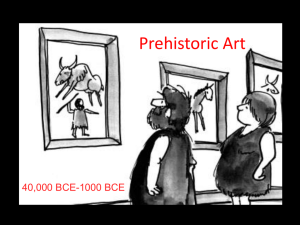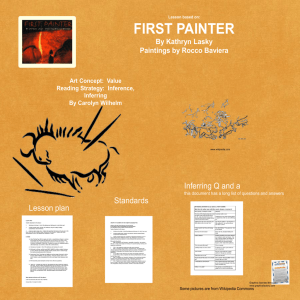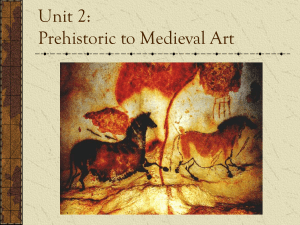ART SEEDS FOR 5-12
advertisement
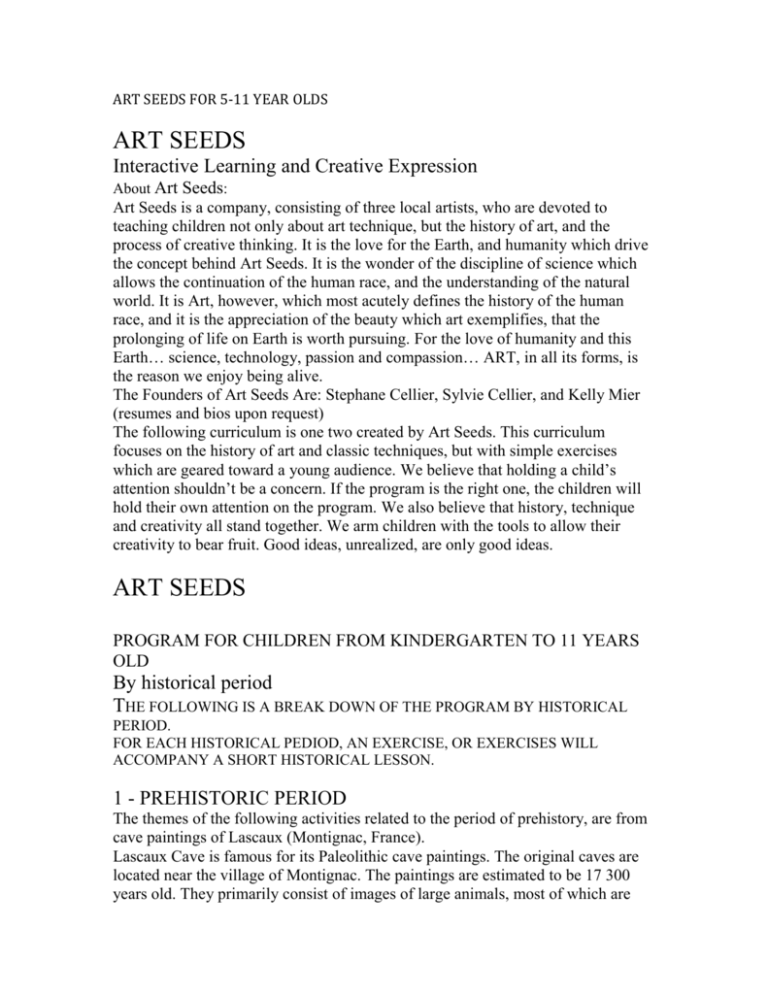
ART SEEDS FOR 5-11 YEAR OLDS ART SEEDS Interactive Learning and Creative Expression About Art Seeds: Art Seeds is a company, consisting of three local artists, who are devoted to teaching children not only about art technique, but the history of art, and the process of creative thinking. It is the love for the Earth, and humanity which drive the concept behind Art Seeds. It is the wonder of the discipline of science which allows the continuation of the human race, and the understanding of the natural world. It is Art, however, which most acutely defines the history of the human race, and it is the appreciation of the beauty which art exemplifies, that the prolonging of life on Earth is worth pursuing. For the love of humanity and this Earth… science, technology, passion and compassion… ART, in all its forms, is the reason we enjoy being alive. The Founders of Art Seeds Are: Stephane Cellier, Sylvie Cellier, and Kelly Mier (resumes and bios upon request) The following curriculum is one two created by Art Seeds. This curriculum focuses on the history of art and classic techniques, but with simple exercises which are geared toward a young audience. We believe that holding a child’s attention shouldn’t be a concern. If the program is the right one, the children will hold their own attention on the program. We also believe that history, technique and creativity all stand together. We arm children with the tools to allow their creativity to bear fruit. Good ideas, unrealized, are only good ideas. ART SEEDS PROGRAM FOR CHILDREN FROM KINDERGARTEN TO 11 YEARS OLD By historical period THE FOLLOWING IS A BREAK DOWN OF THE PROGRAM BY HISTORICAL PERIOD. FOR EACH HISTORICAL PEDIOD, AN EXERCISE, OR EXERCISES WILL ACCOMPANY A SHORT HISTORICAL LESSON. 1 - PREHISTORIC PERIOD The themes of the following activities related to the period of prehistory, are from cave paintings of Lascaux (Montignac, France). Lascaux Cave is famous for its Paleolithic cave paintings. The original caves are located near the village of Montignac. The paintings are estimated to be 17 300 years old. They primarily consist of images of large animals, most of which are known from fossil evidence to have lived in the area at the time. The cave was discovered on September 12, 1940 by four teenagers, Marcel Ravidat, Jacques Marsal, Georges Agnel, and Simon Coencas, as well as Marcel's dog, Robot. The cave complex was opened to the public in 1948. By 1955, the carbon dioxide produced by 1 200 visitors per day had visibly damaged the paintings. The cave was closed to the public in 1963 in order to preserve the art. After the cave was closed, the paintings were restored to their original state, and were monitored on a daily basis. Rooms in the cave include The Hall of the Bulls, the Passageway, the Shaft, the Nave, the Apse, and the Chamber of Felines. Lascaux II, a replica of two of the cave halls — the Great Hall of the Bulls and the Painted Gallery — was opened in 1983, 200 metres from the original. SWIMMING DEER (also known as ‘Frieze of the Swimming Stags’) Frieze of the swimming deer, representing five deer heads, is in the part of the cave called the "nave", on the right wall. What is needed to teach and learn how to draw a deer head? Two parallel lines for the neck The head with a pointed snout (note: the neck and foot together almost look like a fat, upside down foot) A point for the eye Antlers- A fractal tree branch is a good lesson here- as learning to draw a tree branch will also teach a child to draw an antler. List of equipment: – Drawing paper – Charcoal, pastels or crayons (black color tones, brown, red ocher, yellow ocher) Hairspray (for fixing the images for the teacher after the departure of children) 2 – ANTIQUITY The following activities are inspired by art produced by the Egyptians, Greeks and Romans at the time of Antiquity. The themes for the activities are: Egyptian hieroglyphics, decorated Greek vases, the Greek hero Orpheus Charming the Animals, and finally, the Roman mosaic. THE EGYPTIAN HIEROGLYPHICS : GREEK VASES DECORATED : ORPHEUS AND ANIMALS THE ROMAN MOSAIC THE EGYPTIAN PROFIL REPRESENTATION THE DOMUS AUREA AND THE GROTESQUES CREATURES OF GREEK MYTHOLOGY Draw a creature from Greek mythology from its description ... The purpose of this lesson is to provide children with a chance to use his/her inner eye and imagination. Their drawing will be done by listening to an oral description’ Descriptions of various creatures of Greek mythology (centaur, Cerberus, chimera, etc.) will be distributed to children. These can be simple pencil drawings that can serve as a "draft" to later paint on a plate made of clay. List of equipment : - White drawing paper - Pencils - Rubber Extensions : Find books on tales of Greek mythology explained to children Make a drawing about a Greek mythology story Showing pictures of historical monuments (not necessarily antique) with mosaic pavements of Roman archaeological sites with mosaics preserved ... of Roman archaeological museum collection of the Domus Aurea And ... 3 - BETWEEN MIDDLE AGE AND RENAISSANCE The activities in this section are subject to the period of the Middle Ages to the Renaissance, that is to say, roughly between the sixth and sixteenth centuries after. JC. DROP CAPS IN THE MIDDLE AGE MANUSCRIPTS Most writing in the middle ages was done by monks. The writing was elaborate and beautiful. Many times the first letter of a paragraph or the name of an important person was larger and more colorful the test of the manuscript. Inside these larger letters the writer would sometimes include a picture. These are called drop caps. Decorate the drop cap of the first letter of each of the children first name ... The teacher will write in Gothic script the names of each of the children (kindergarten) in black marker on watercolor paper type. Older children can use a Gothic alphabet model to write their own names. The children will then decorate the drop cap of their first name with colored pencil and / or watercolor. Then they can add a drawing inside of the drop caps drawing. List of equipment : - Thick drawing paper type watercolor paper - Watercolors of various colors - Crayons - Brushes – Black marker (for the teacher to write the names) THE LADY WITH THE UNICORN STAINED GLASSES VENICE CARNIVAL TRACING PAPER EGG TEMPERA THE MANNER OF GIUSEPPE ARCIMBOLDO PERSPECTIVE STUDY OF MONSTERS BY JEROME BOSCH THE DUKE OF BERRY 4 – BETWEEN THE SEVENTEENTH AND NINETEENTH CENTURY The following activities have been inspired by themes, artists and materials used in art between the seventeenth and nineteenth century. THE STILL LIFES 3 PENCILS ART THE ANTOINE LOUIS BARYE SCULPTURES OF ANIMALS PASTEL TECHNIQUE : EUGENE DELACROIX EXAMPLE GUSTAVE MOREAU AND WATERCOLOR GUSTAV KLIMT - THE KISS Create a collage inspired by Kiss Gustav Klimt ... We cut colored paper in various forms and printed and cut the heads and arms of the characters in the painting of Gustav Klimt. The children then make a collage from these inspired painting. CHIAROSCURO LUBIN BAUGIN – THE FIVE SENSES CLAUDE LE LORRAIN - LANDSCAPES WASH JEAN SIMEON CHARDIN - ATTRIBUTES OF ARTS 5 - CONTEMPORARY AGE POINTILLISM AND GEORGES SEURAT CUTTINGS OF HENRI MATISSE Make a composition with pieces of paper ... The children cut out colored paper and make collages to make characters or other compositions inspired by the works of Henri Matisse. List of equipment: - Paper of various colors - Glue sticks or vinyl liquid glue - Small scissors Extensions : - Show several artworks of MATISSE COMIC BOARDS INTRODUCTION: COLORING OF CASES AND FILLING OF BUBBLES THE “CADAVRE EXQUIS” PABLO PICASSO – PORTRAITS 6 – PRIMITIVE ARTS The term "Primitive Arts" is generally used to refer to artistic productions called "primitive" or "ethnic" societies. It is often used to describe actually artistic productions of non-Western cultures (Africa, Oceania, South America, ...). AFRICAN MASKS ABORIGINAL ART
